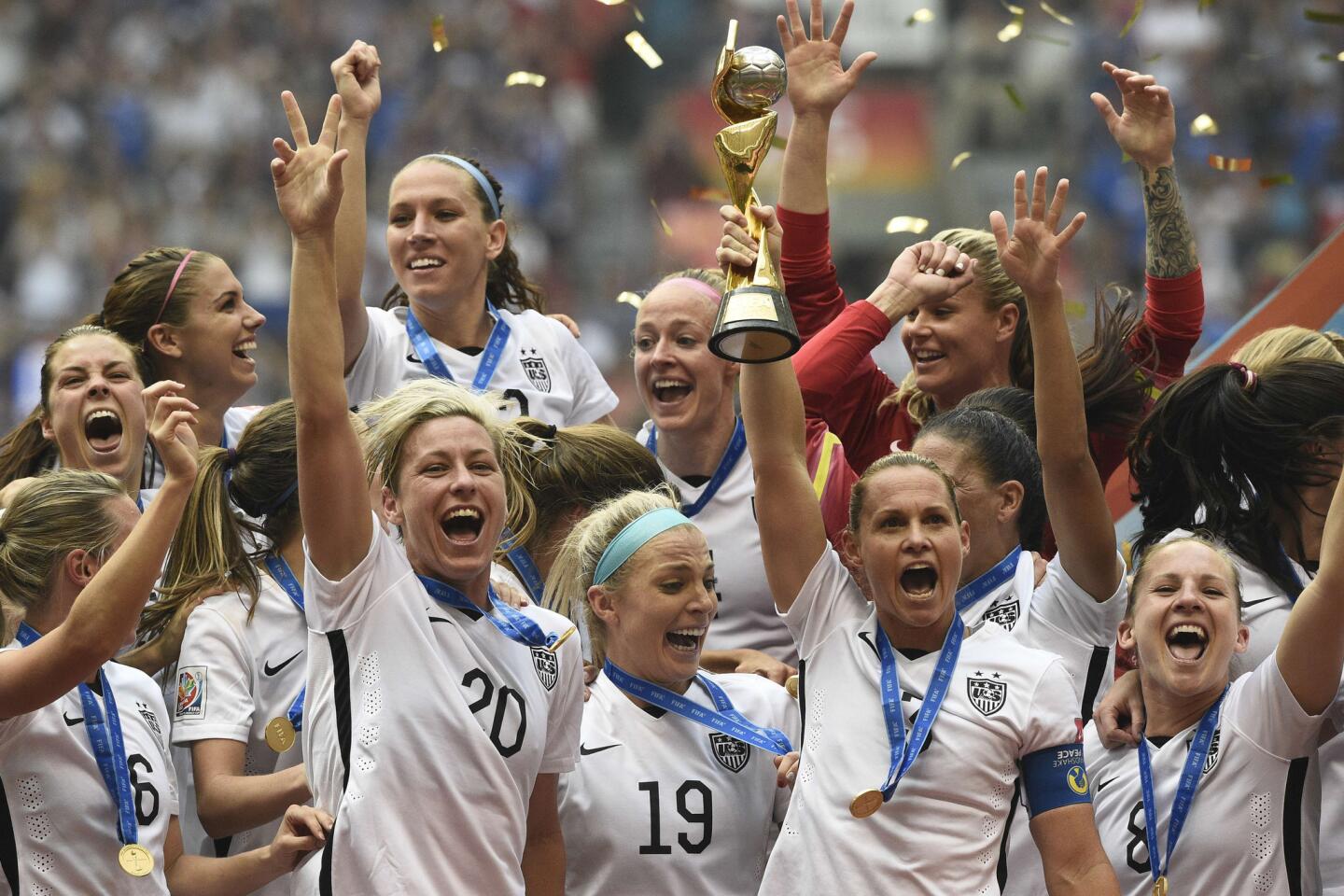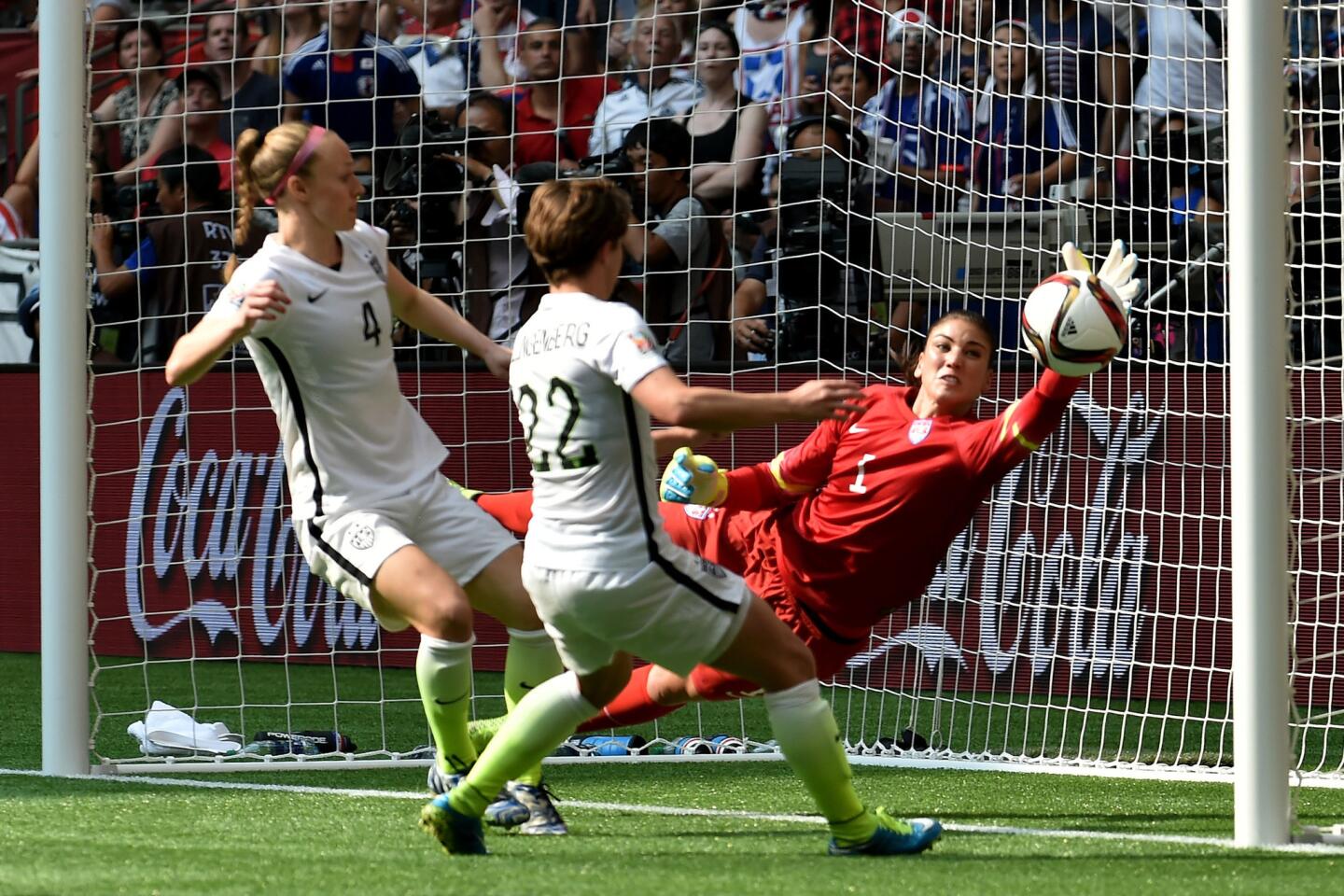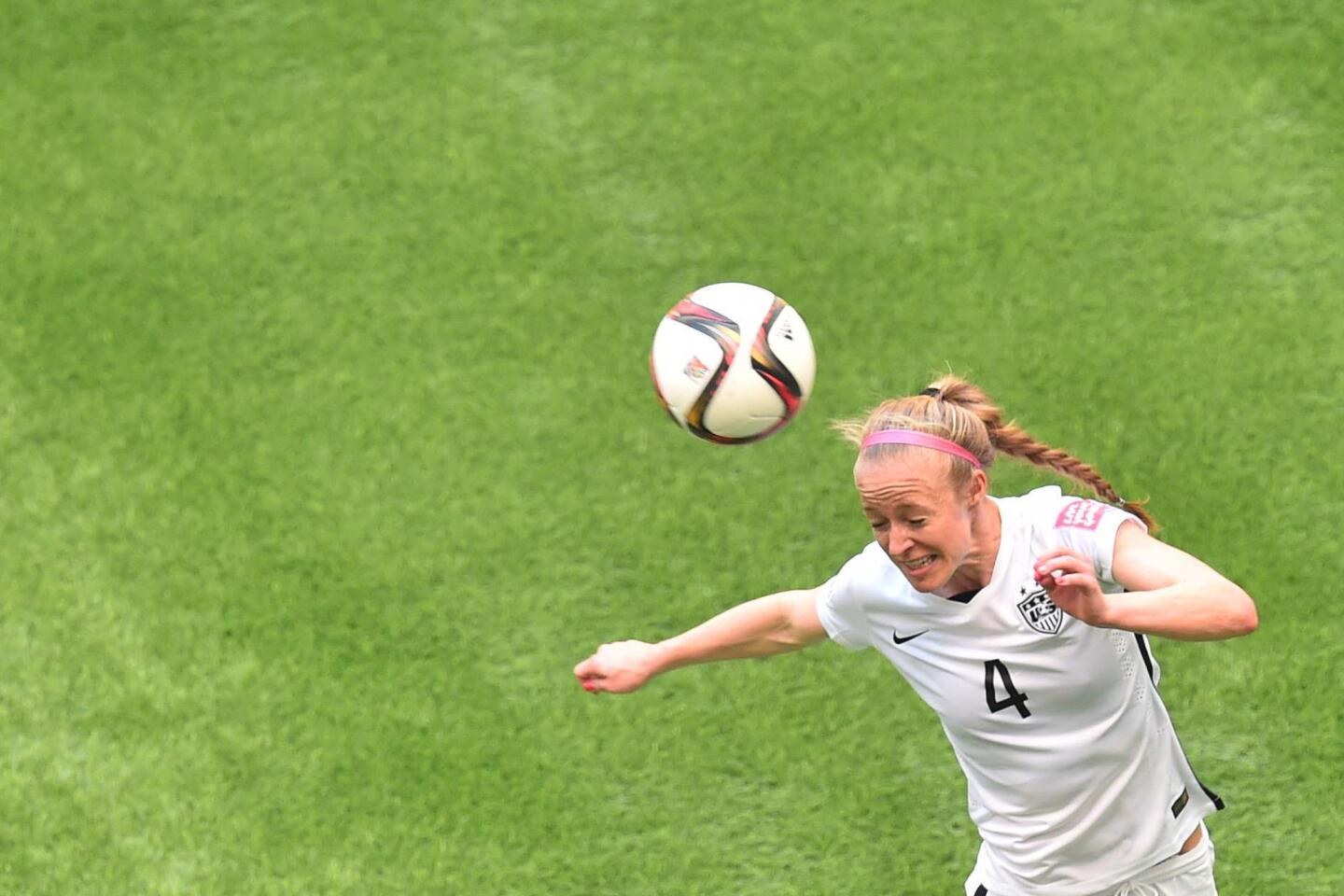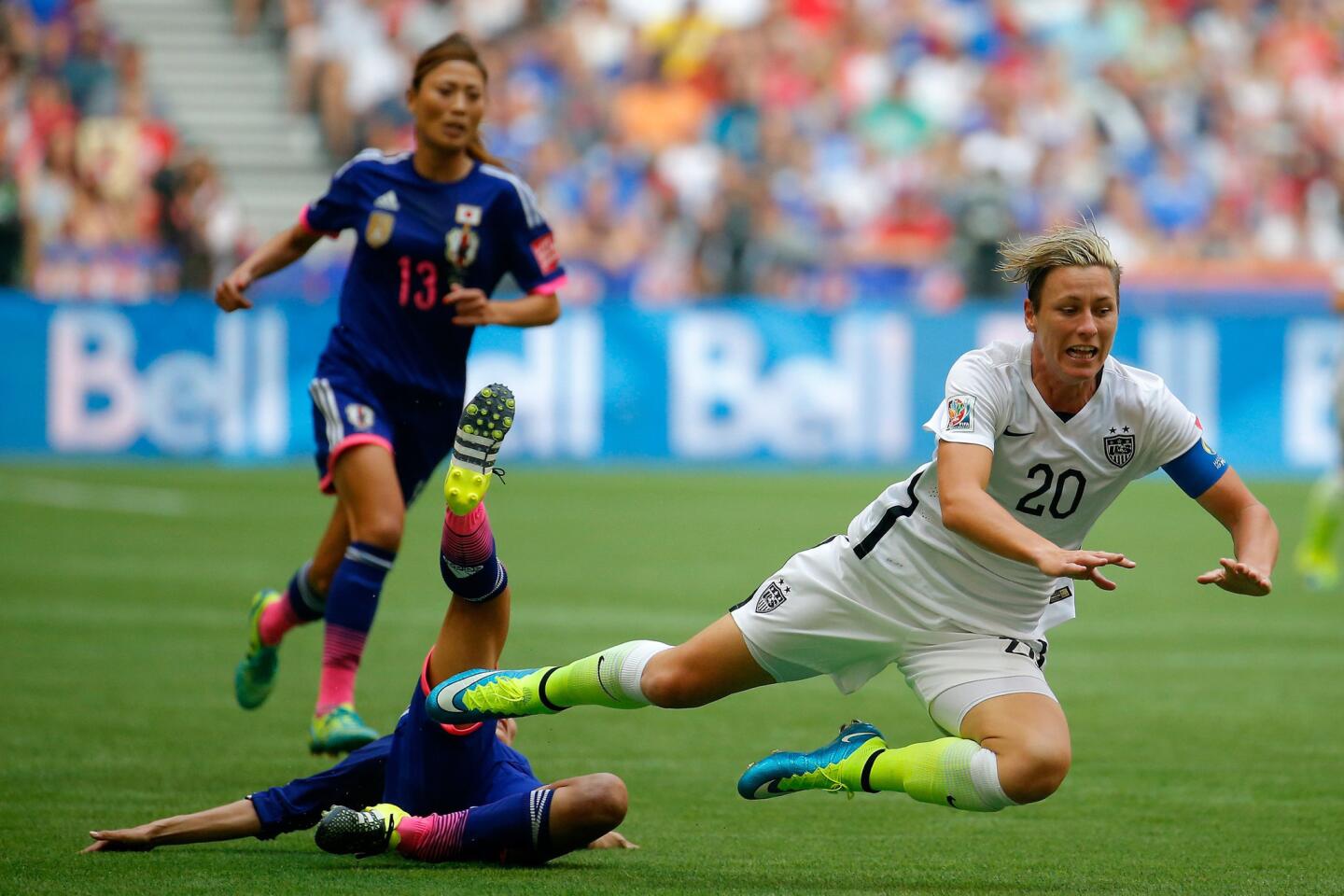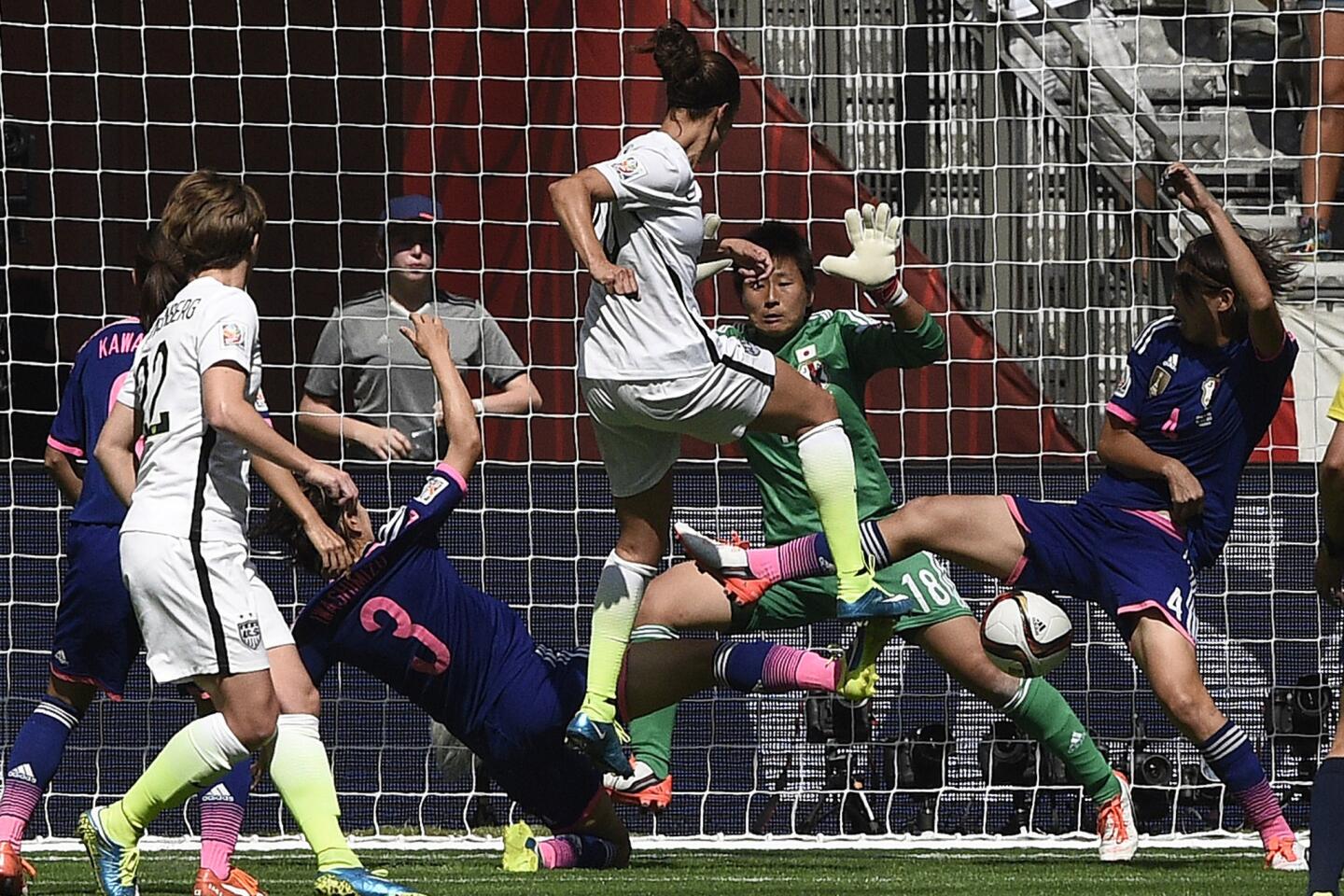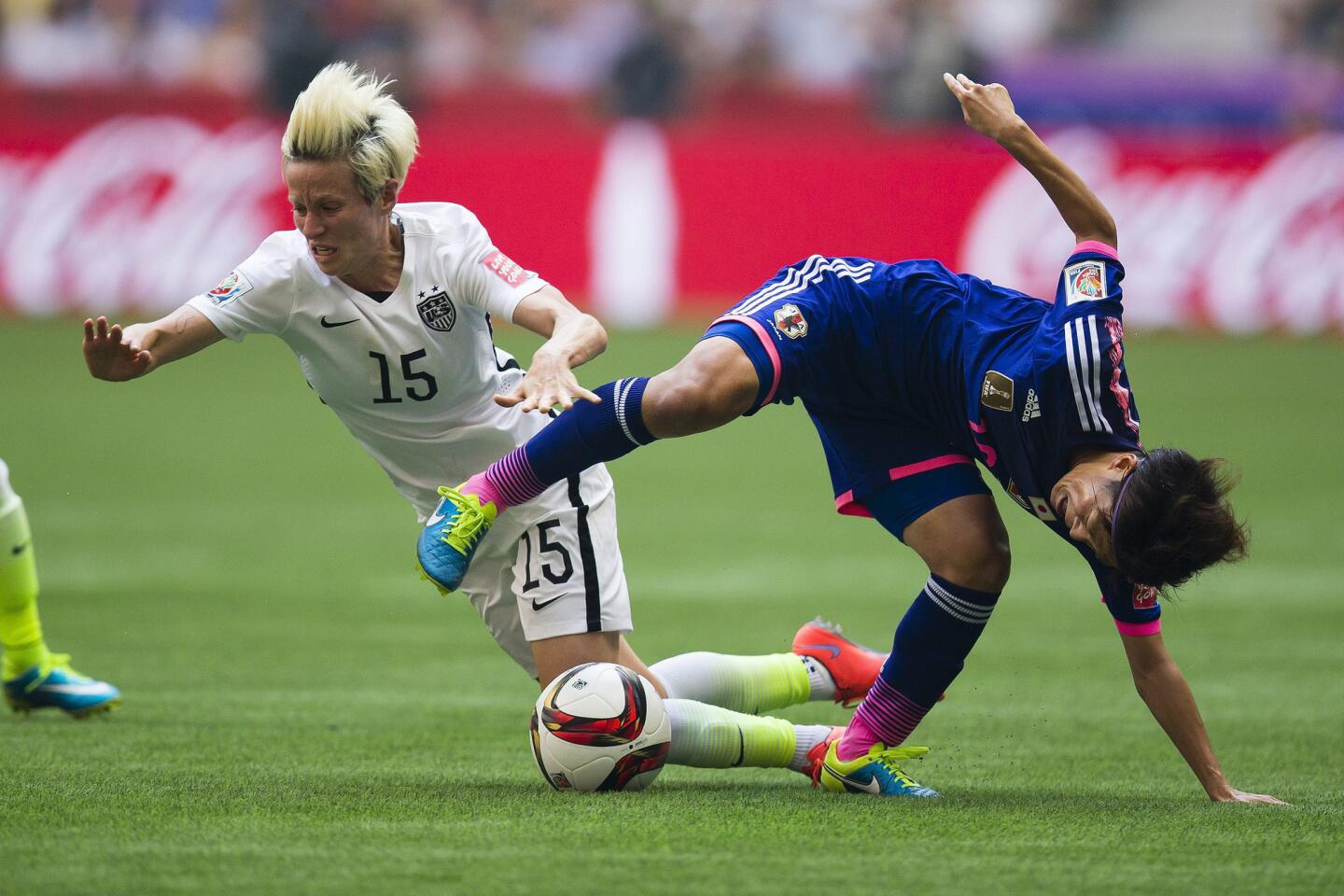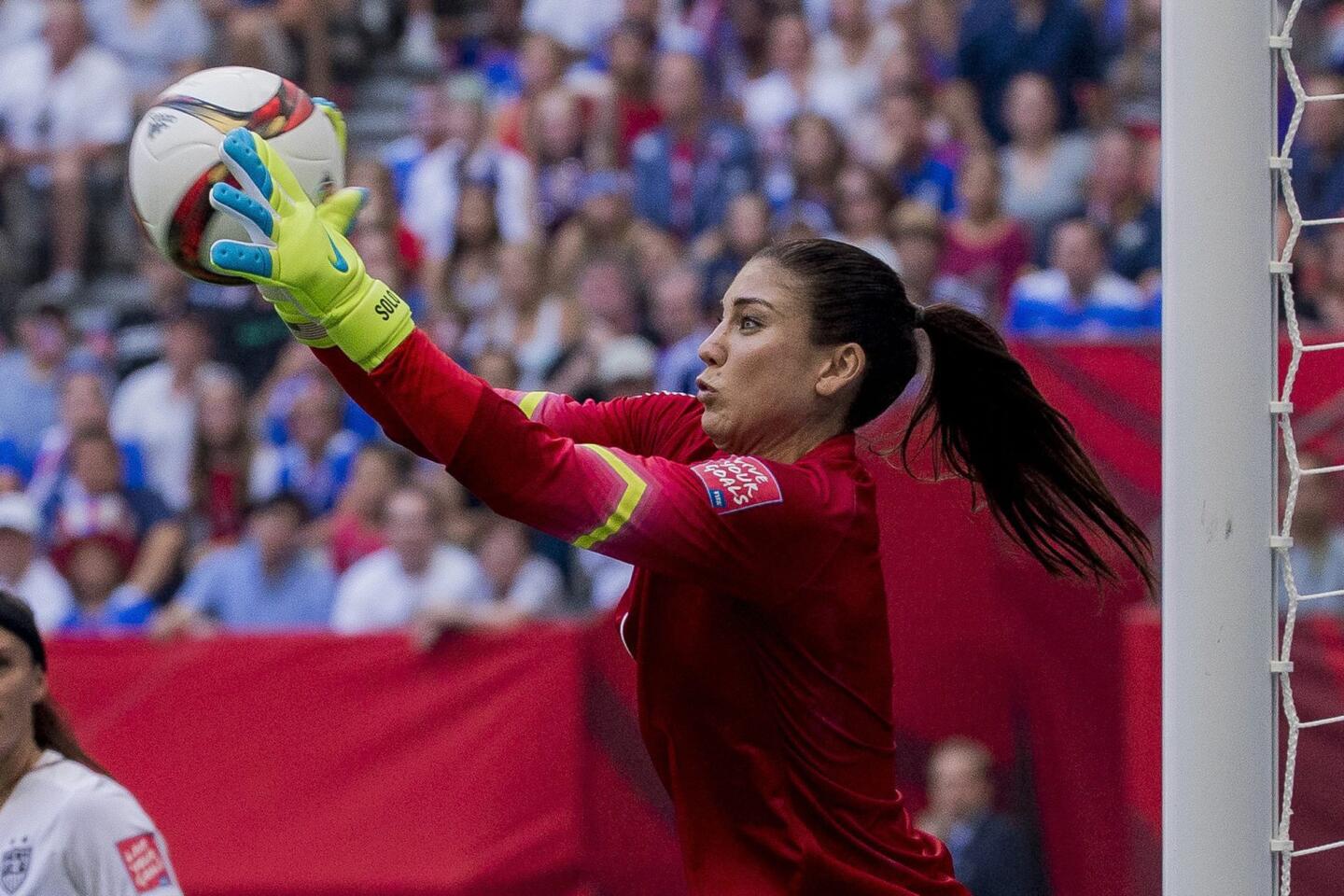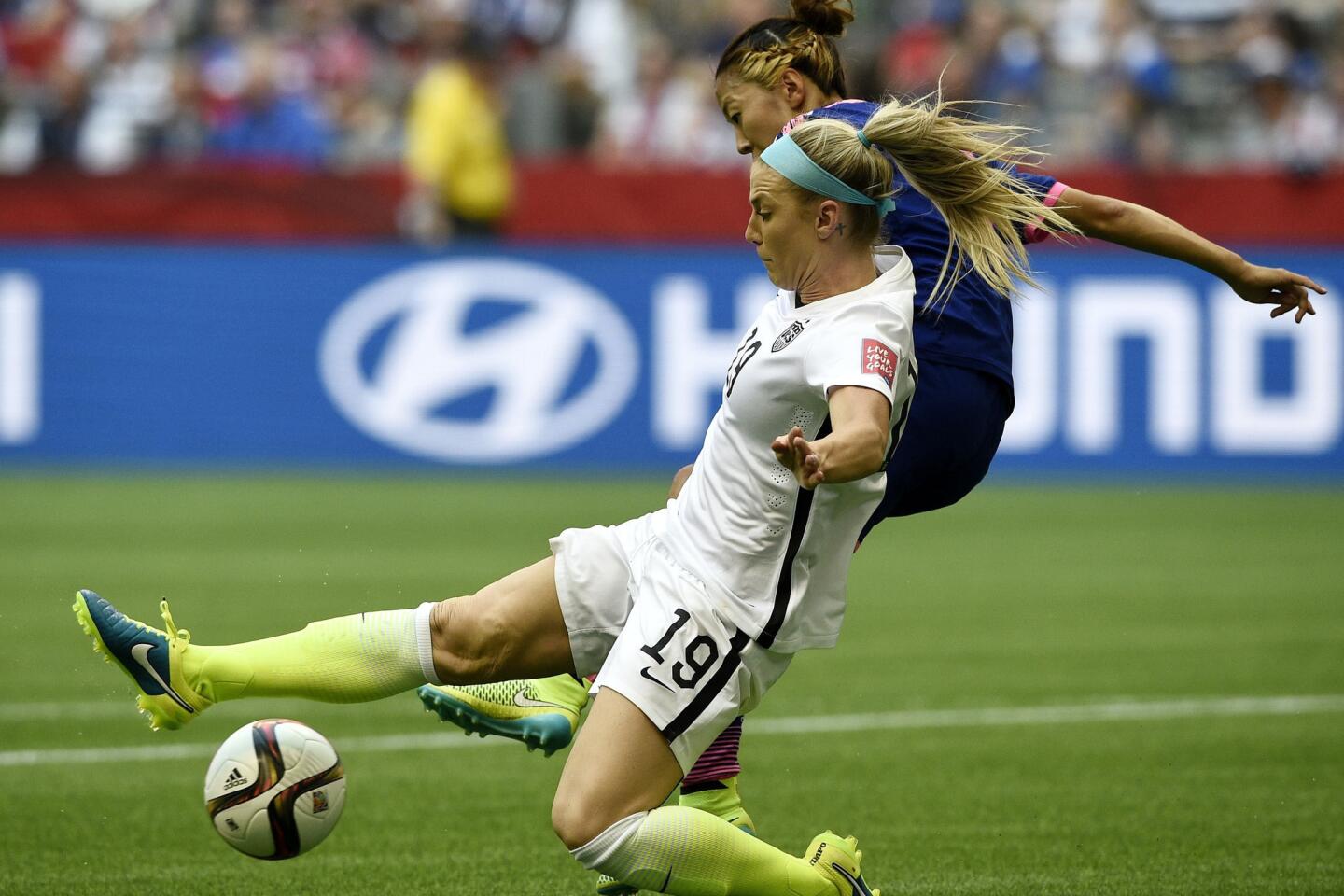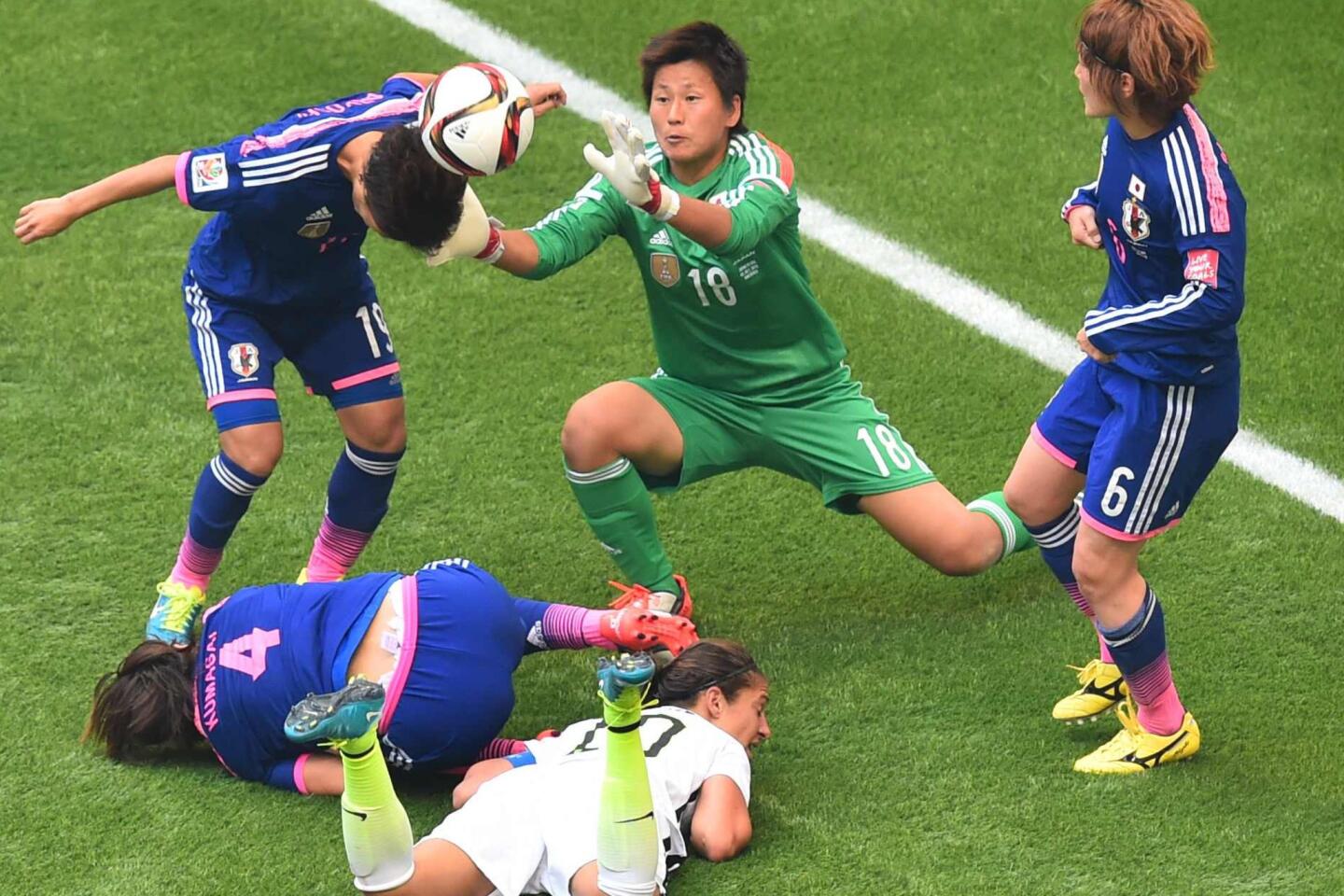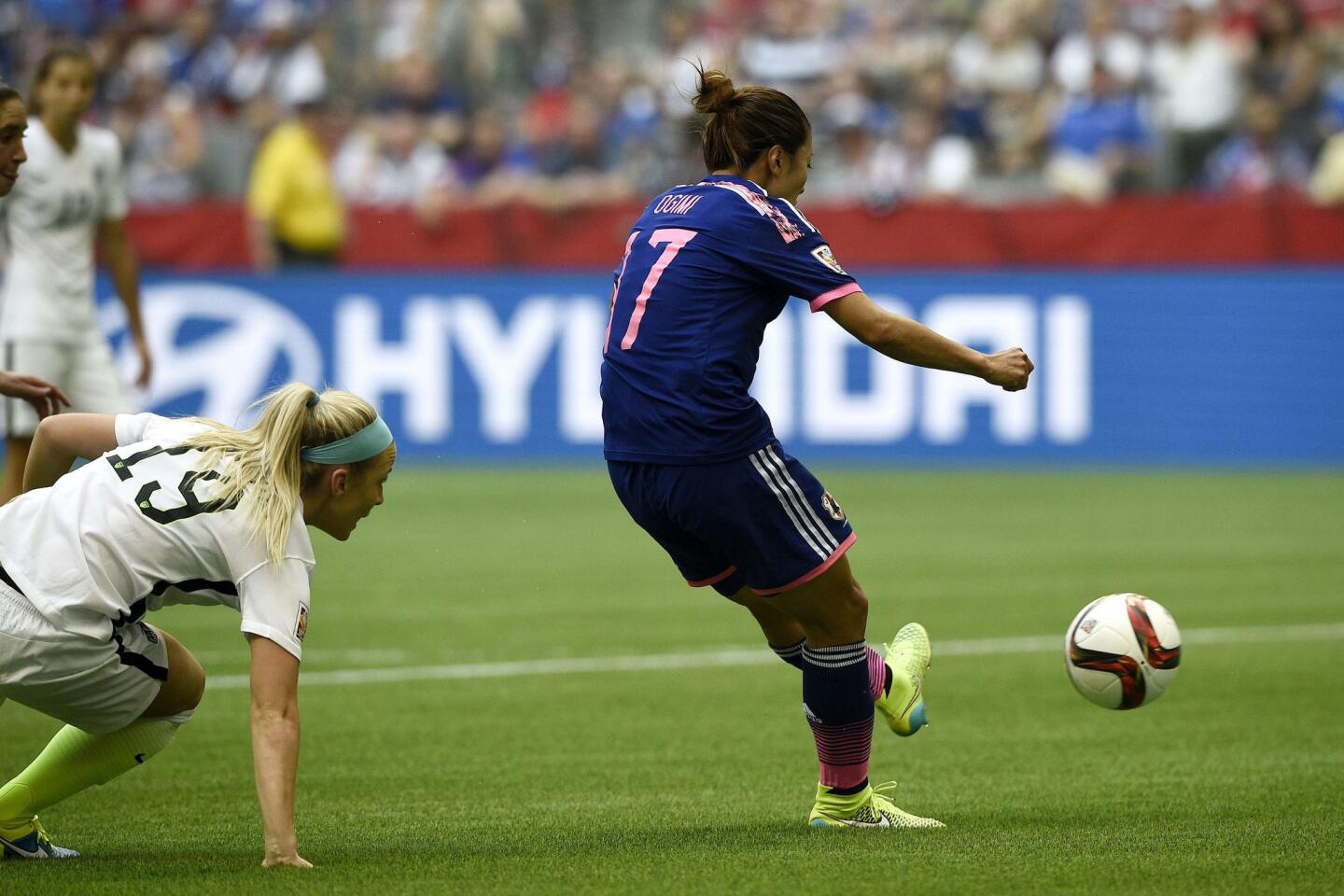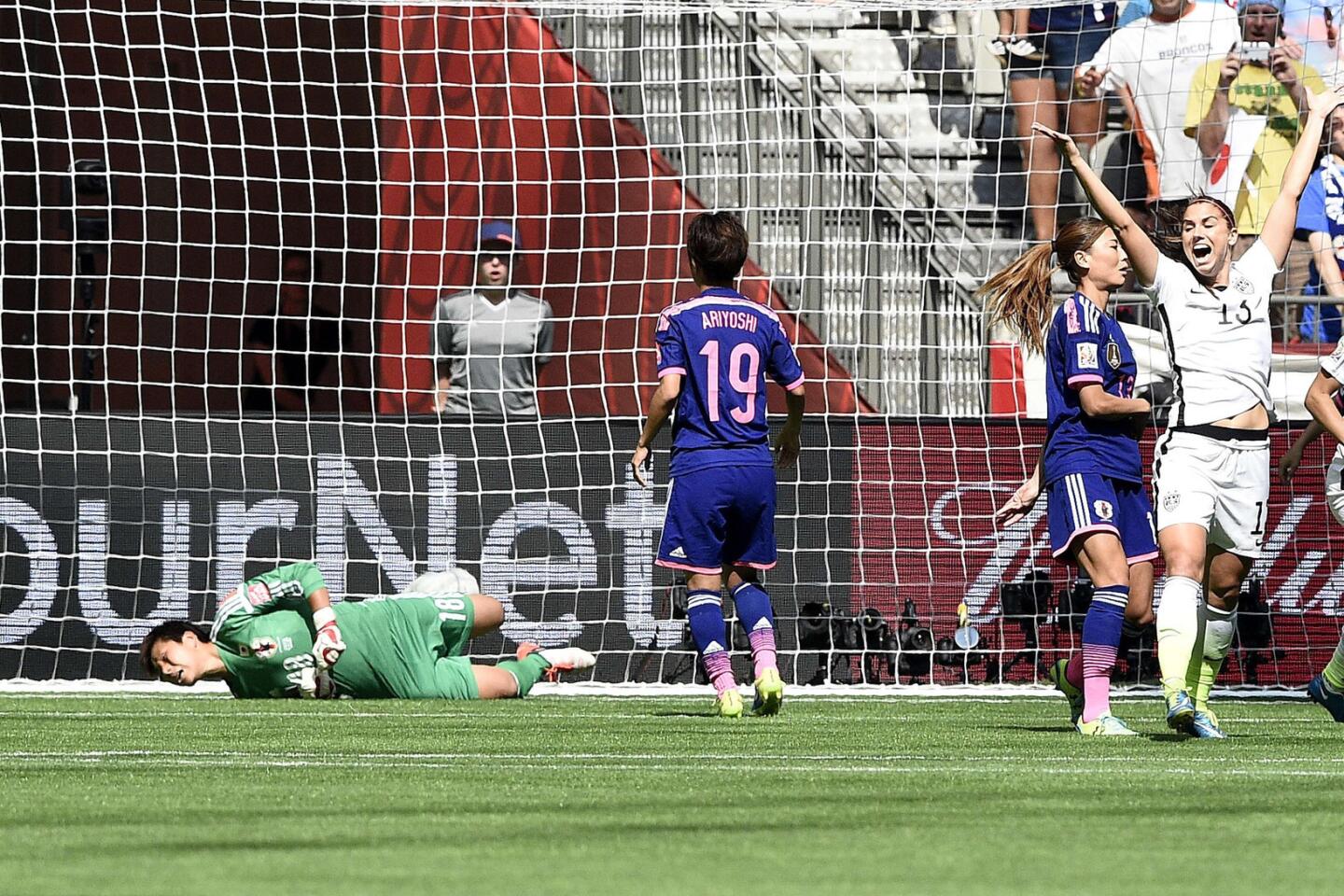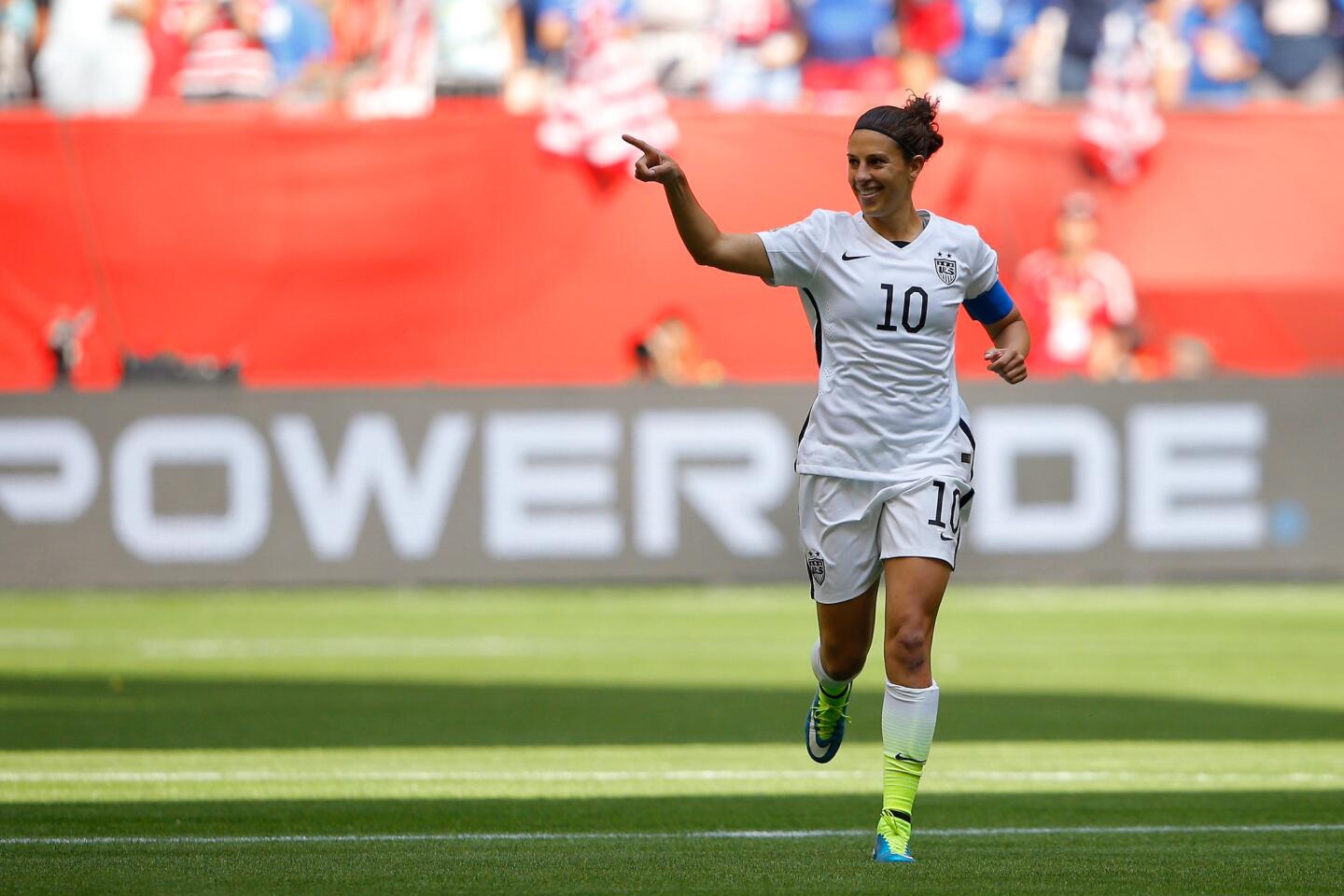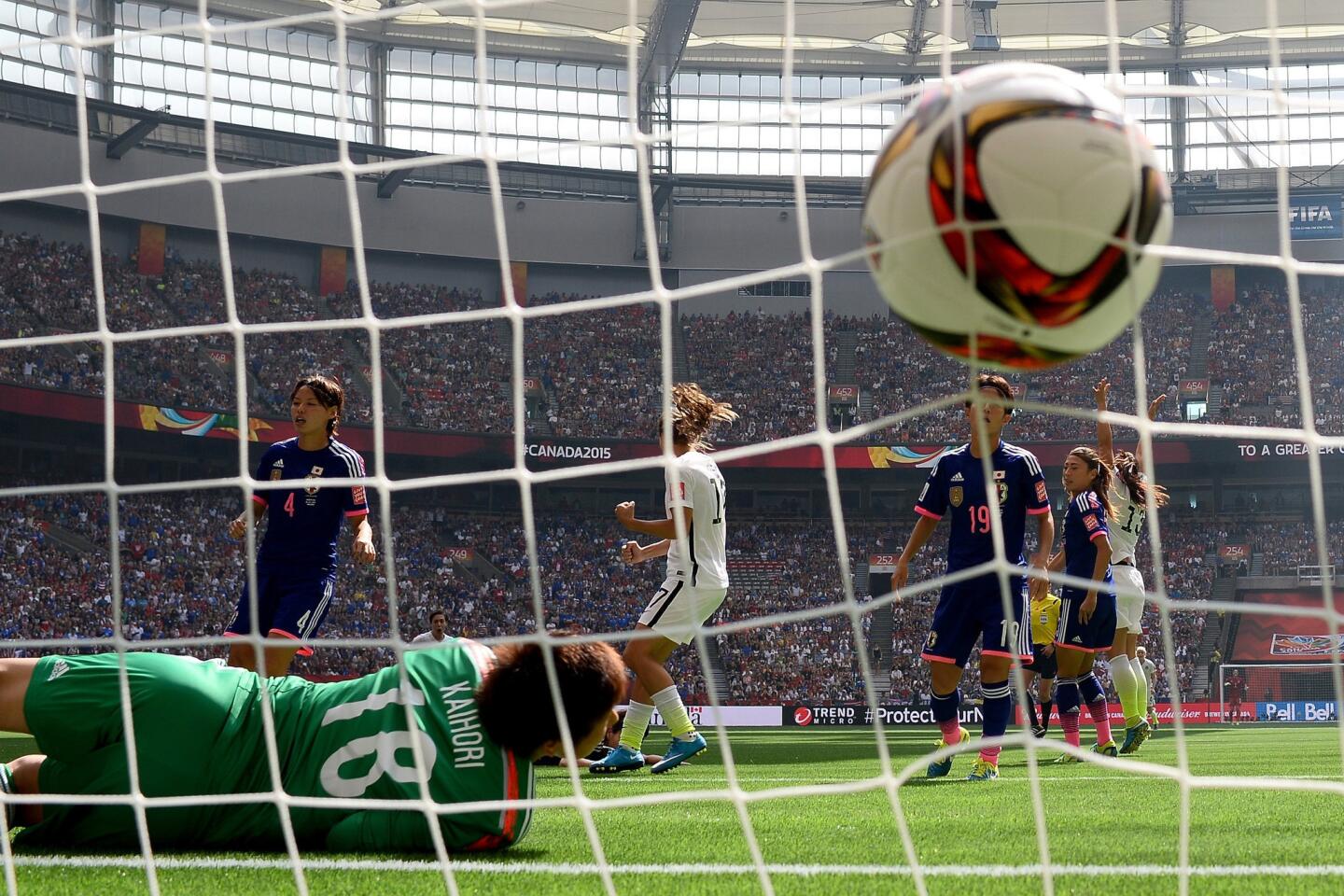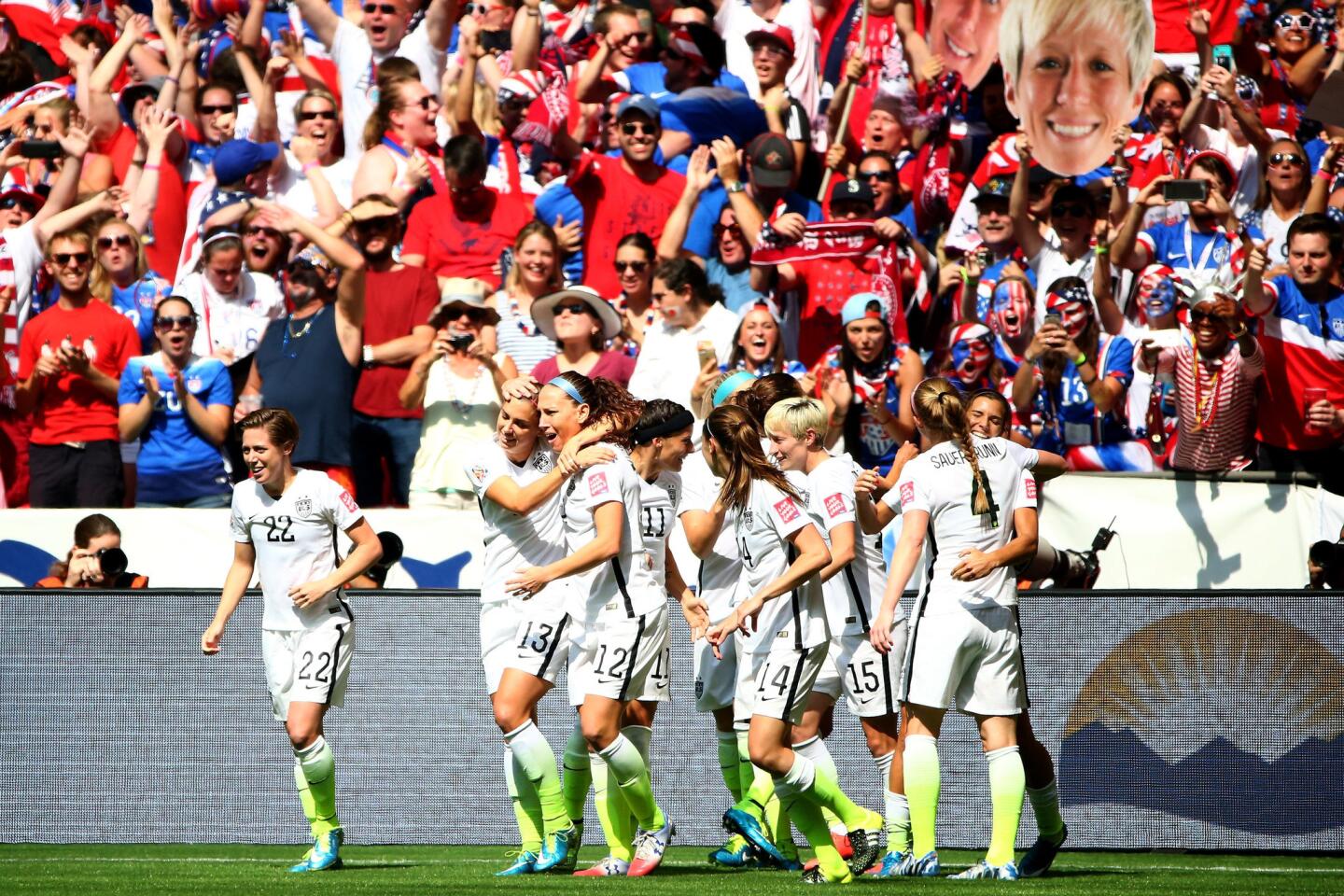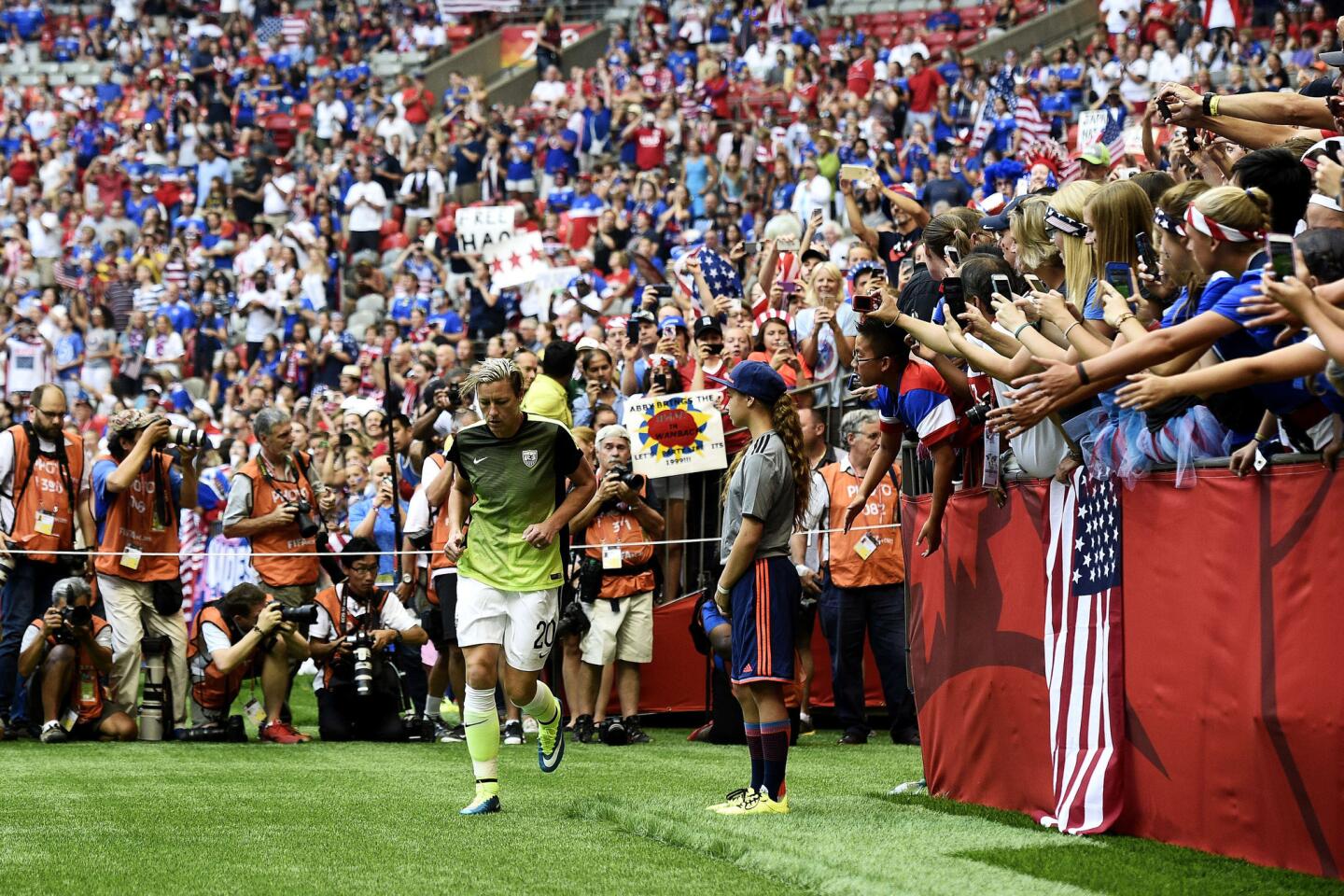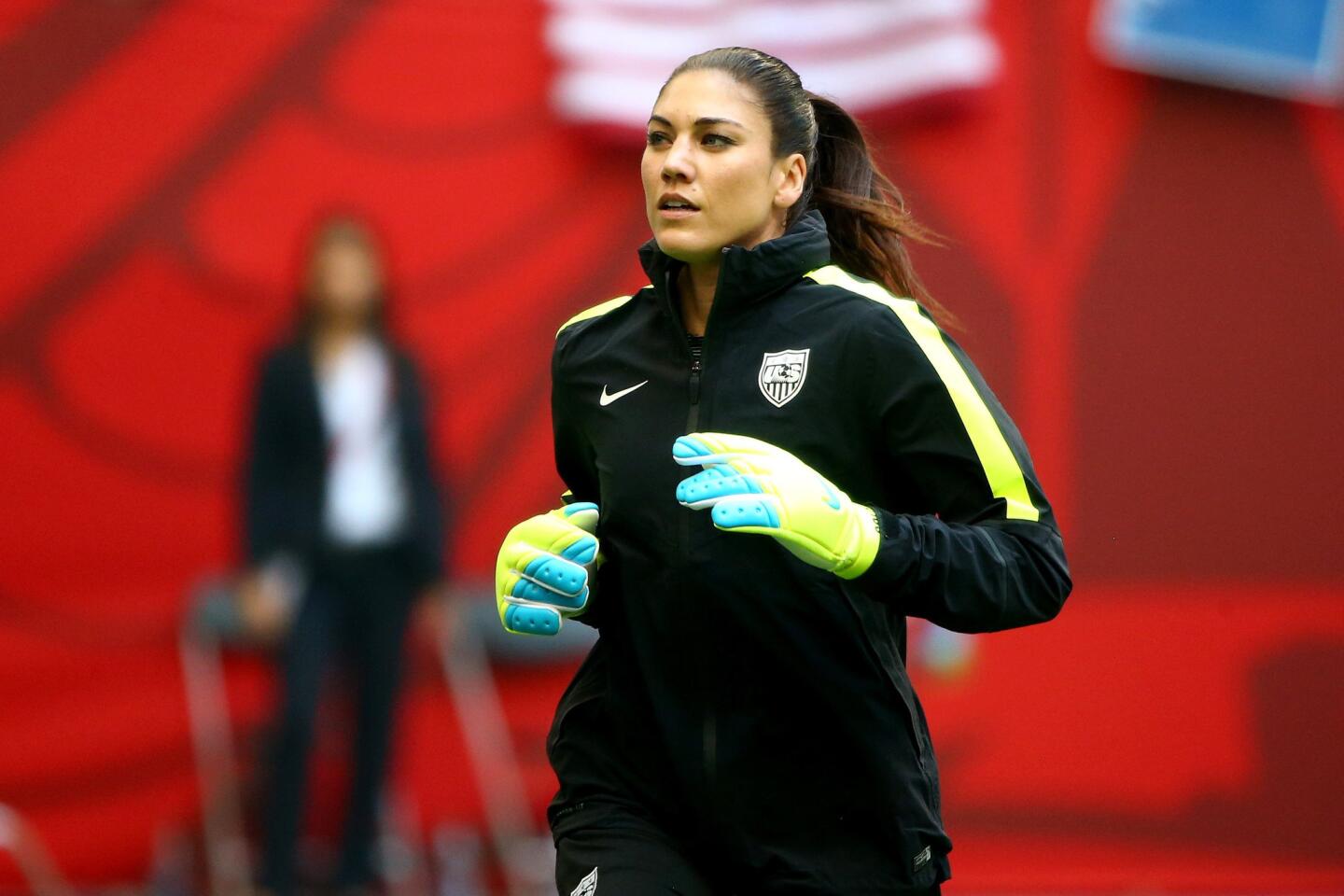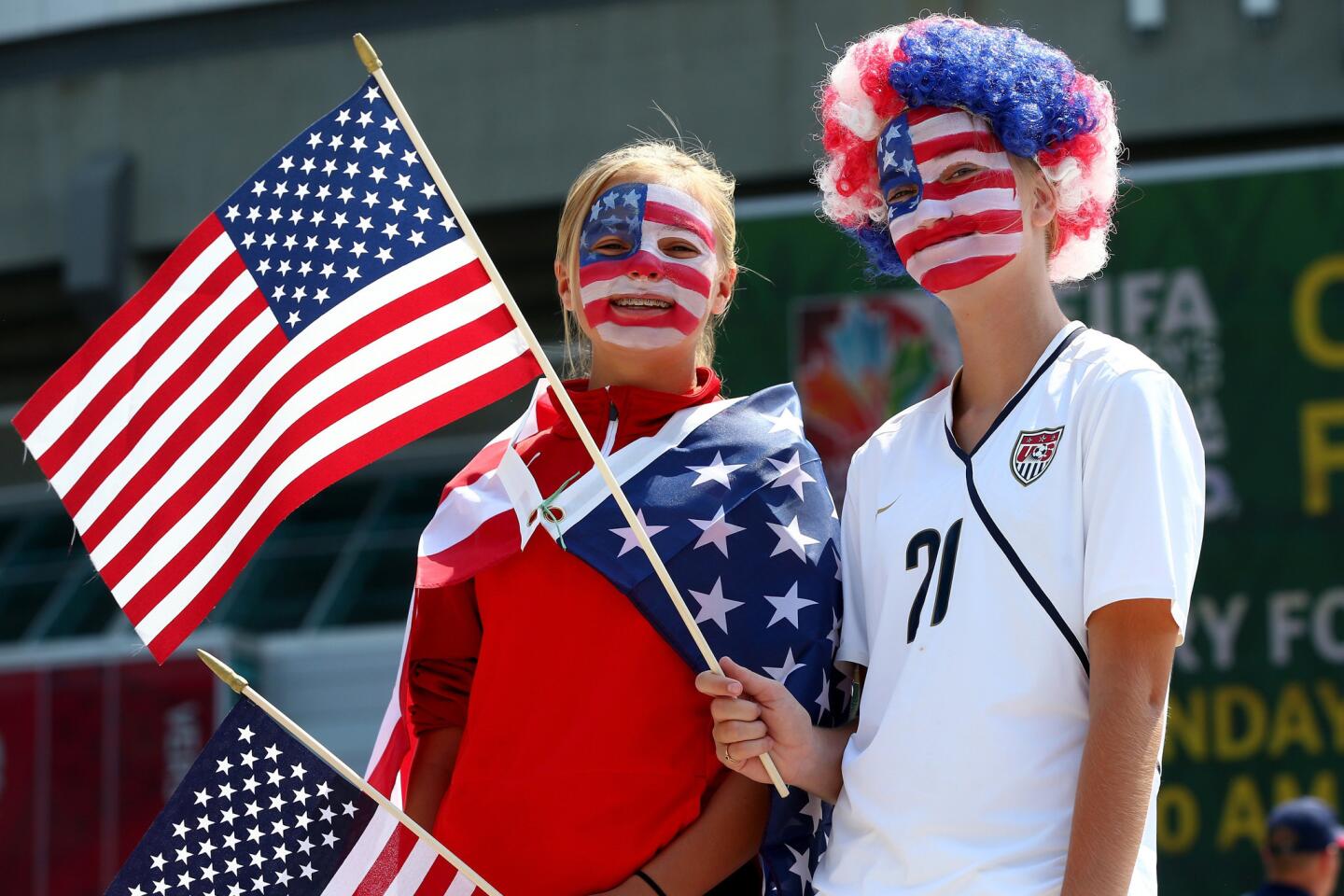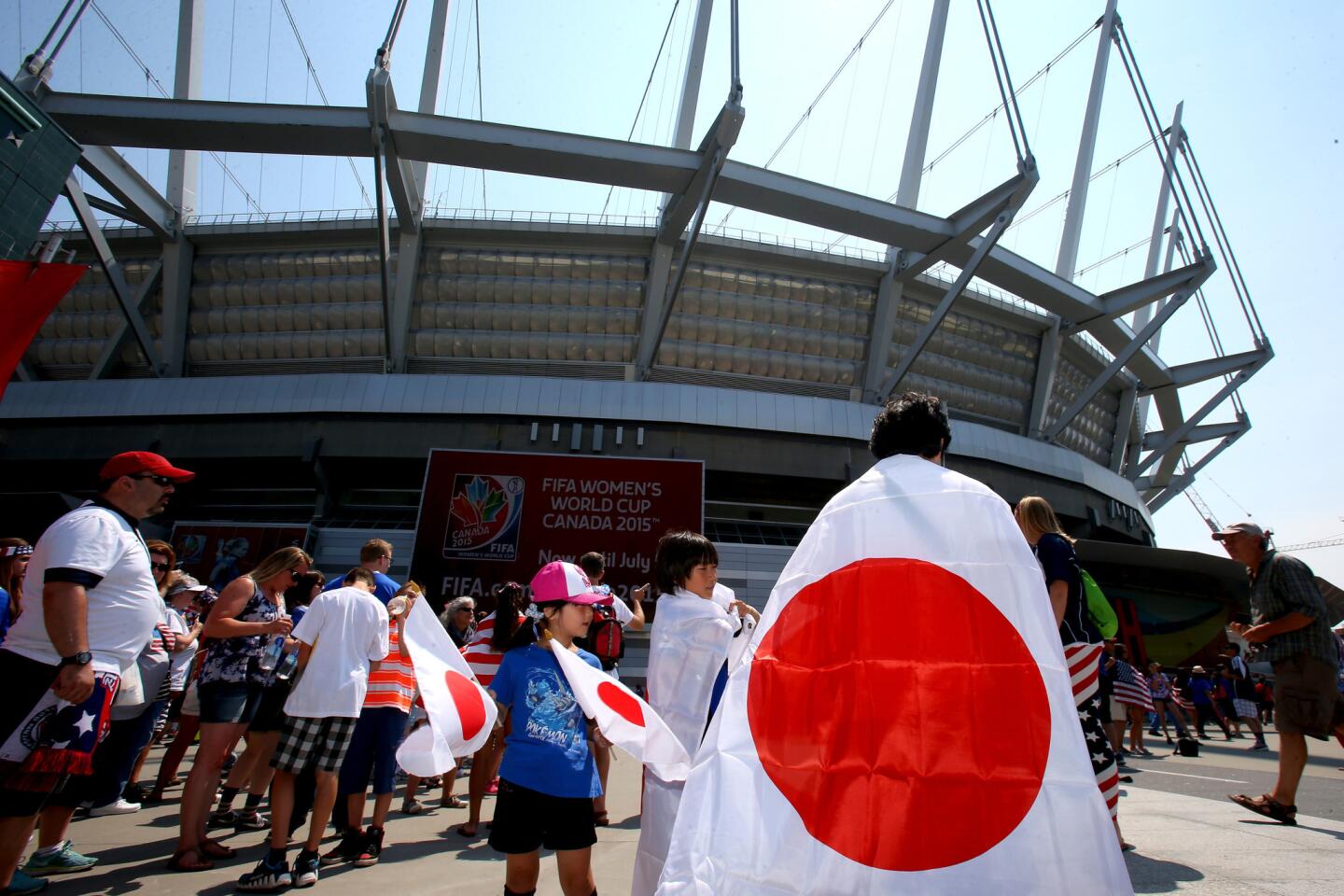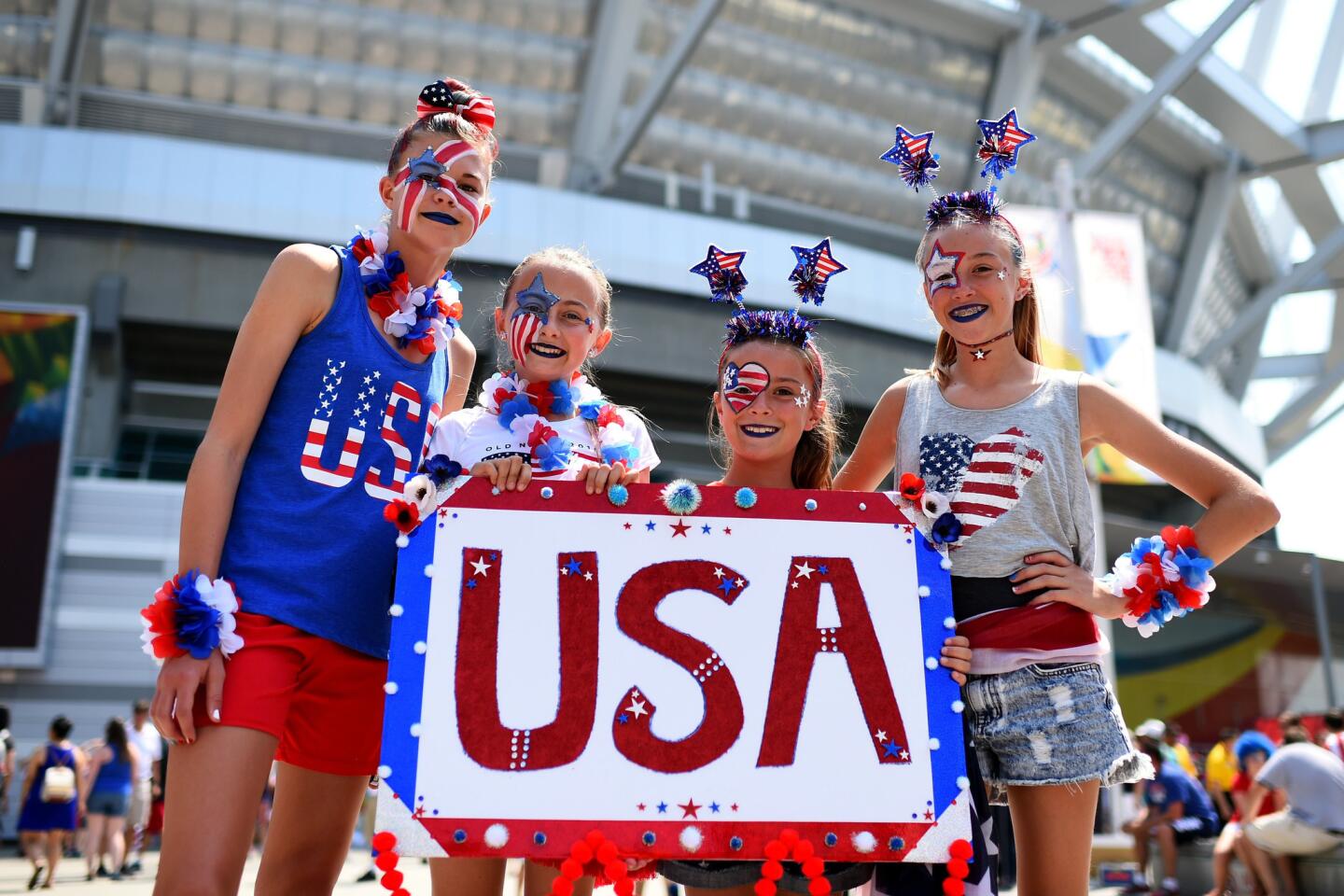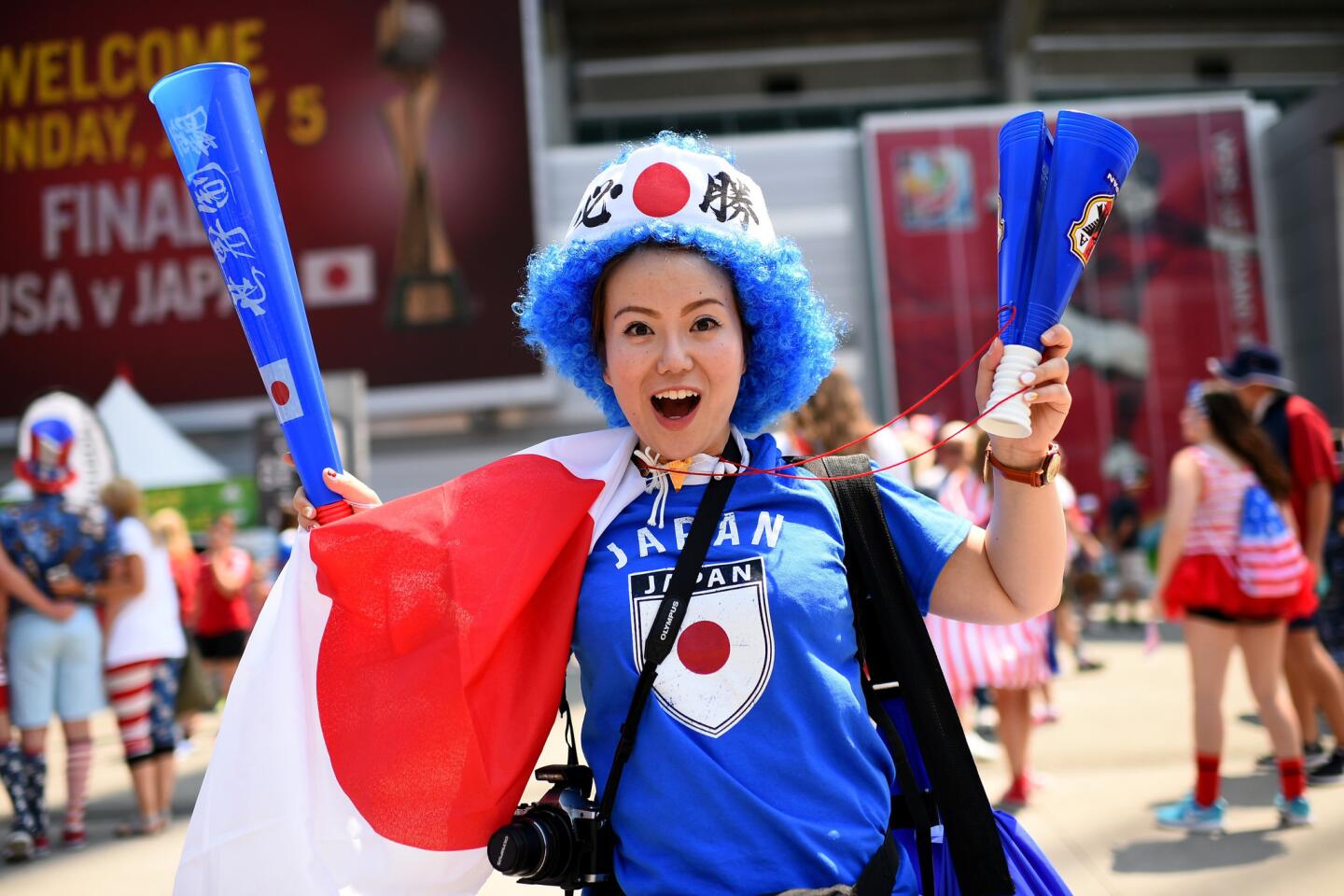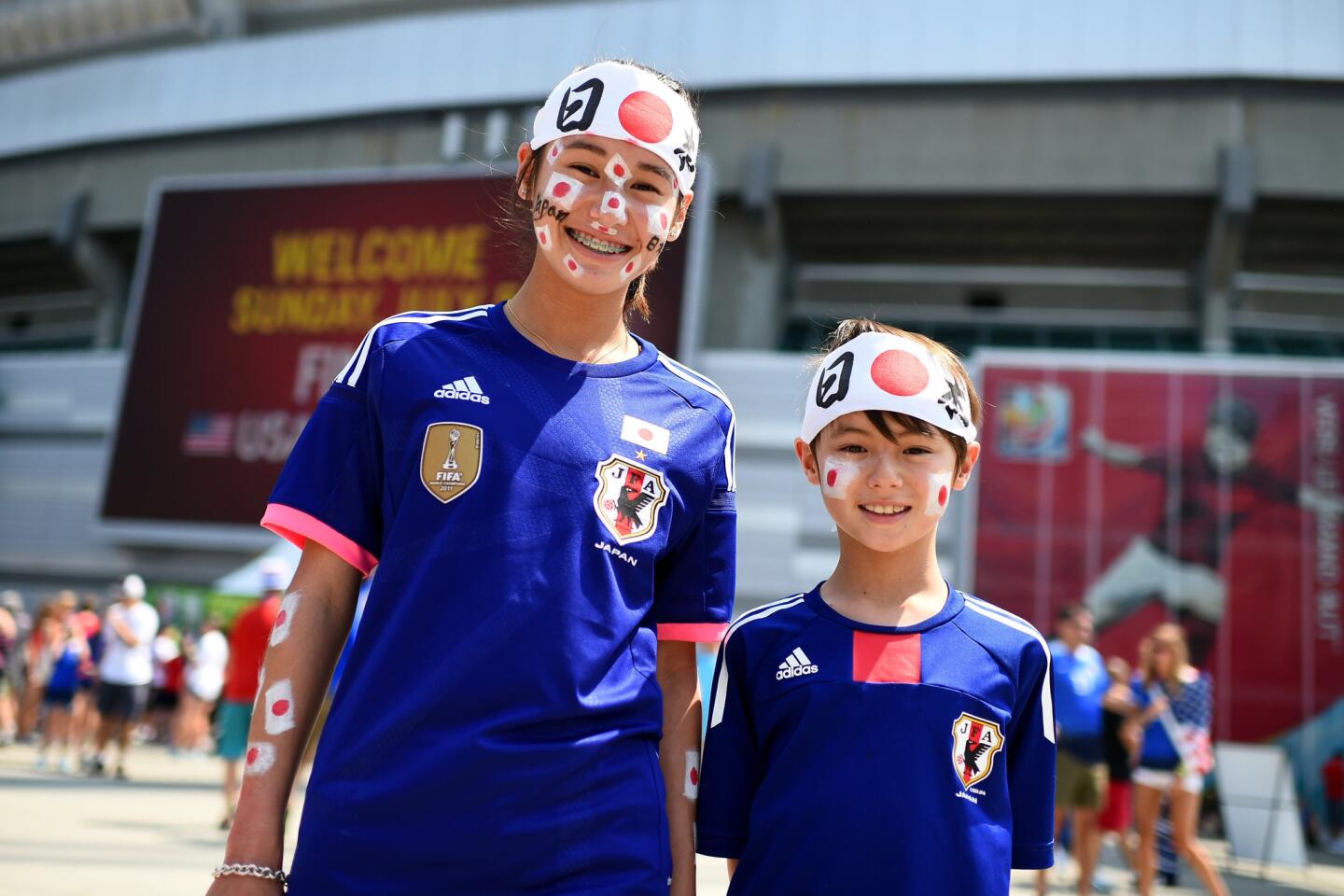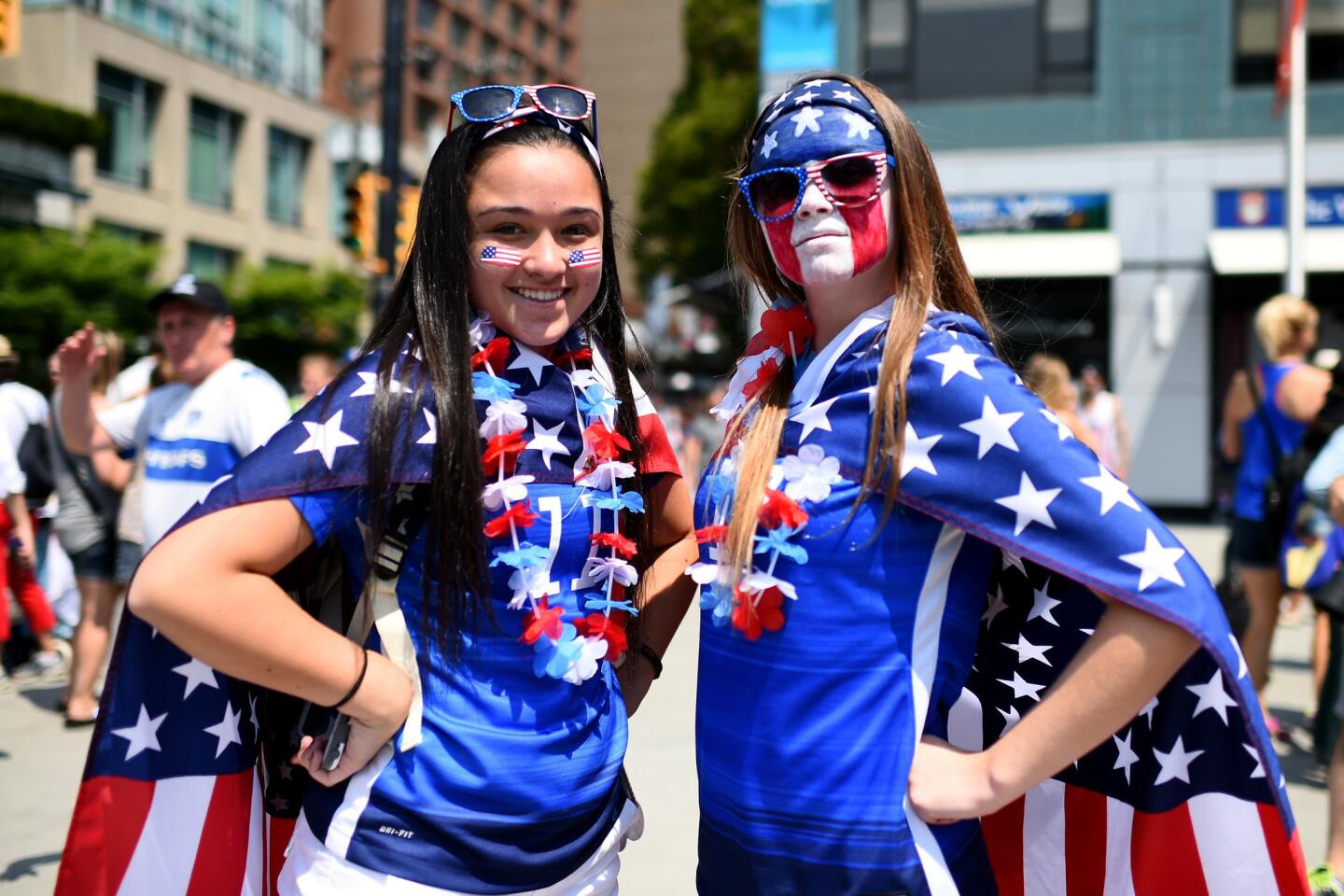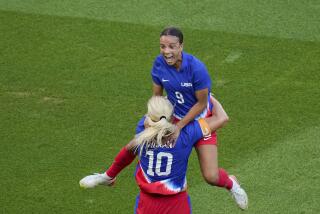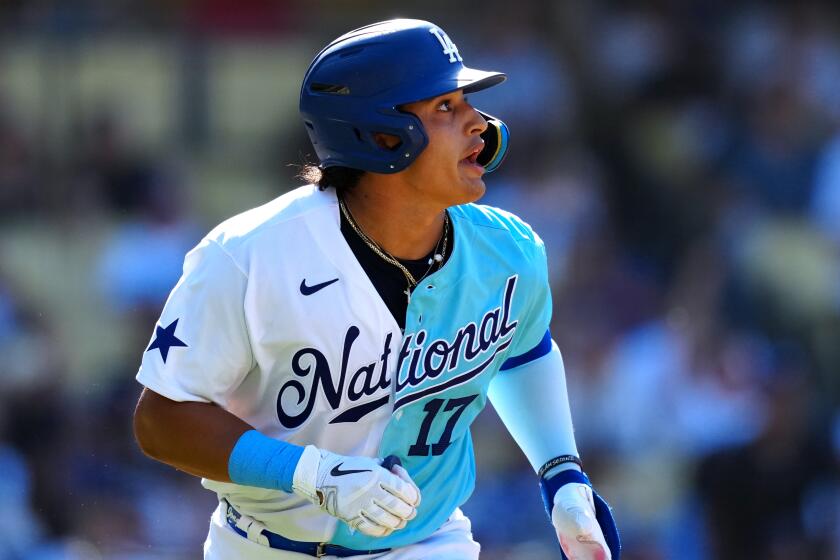U.S. exorcises ghosts of ’99 with rout in Women’s World Cup final
Reporting from Vancouver, Canada — For a time when she was younger, Carli Lloyd wasn’t sure she belonged on the U.S. national team.
And just two weeks ago she wasn’t sure where she fit into the U.S. attack in this Women’s World Cup.
But on Sunday Lloyd finally found her place — in the record books — after scoring three goals in the first 16 minutes of the World Cup final, leading the U.S. to a convincing 5-2 win over Japan before an overwhelmingly pro-American crowd of 53,341 at BC Place.
The five goals were the most scored by one team in a Women’s World Cup final, while for Lloyd the hat trick, the first in a title game, gave her six goals, tied for most in the tournament.
Three of those scores put her team ahead to stay, making Lloyd an easy winner as the World Cup’s best player and making the U.S. the first country to win three women’s world titles.
“It’s a little surreal moment,” Lloyd said. “It’s been amazing. We just wrote history today and brought this World Cup trophy home.”
Almost as important, Sunday’s performance chased away the stubborn ghosts of 1999 that have haunted the U.S. women since they last won a World Cup.
“It’s been a lot of years in between ’99 and now. And I think it’s time,” said defender Christie Rampone, the only woman to play for both teams and, at 40, the oldest woman to play in a World Cup.
“I hope it’s not compared to ’99 anymore. I hope it’s leading on to the next team that wins the World Cup. That’s the standard.”
Lloyd may have set a new standard Sunday.
Her first two goals came on similar set pieces — the first on a corner kick by Megan Rapinoe in the third minute and the second on a free kick by Lauren Holiday two minutes later. On both plays Lloyd started at the edge of the penalty area, then charged into the box unmarked to latch on to loose balls and redirect them in.
But her third goal was clearly the best of the tournament. As she dribbled toward midfield, Lloyd looked up to see that Japanese keeper Ayumi Kaihori had strayed dangerously far from the net. So she fired a right-footed shot from 50 yards out.
Kaihori, backpedaling furiously, got the fingers of her right hand on the ball but that wasn’t enough to stop it, as it hit the turf then kissed the left post before going in to give the U.S. a 4-0 lead.
For Japan it was a nightmare — one it had seen before. Lloyd, who scored the only goal in the U.S. victory over Brazil in the 2008 Olympic final, scored twice to beat Japan in the 2012 gold-medal game.
That’s six goals and three wins in three finals — two of them against Japan.
“She always does this to us,” Japan Coach Norio Sasaki said. “We are a little embarrassed. But she is an excellent player.”
Japan offered a murmur of protest in the 27th minute when Yuki Ogimi scored after defender Julie Johnston tumbled to the turf. That was newsworthy since it was just the second goal the U.S. had allowed in this World Cup.
Japan’s second score, in the opening minutes of the second half, again came courtesy of Johnston, who headed the ball into her own goal, cutting the U.S. lead to 4-2.
But midfielder Tobin Heath quickly got that back in the 54th minute, accounting for the final score and bringing Abby Wambach her elusive World Cup title, the only item that had been missing from a resume that includes two Olympic crowns, a world player-of-the-year award and the most international goals — 183 — in history.
And it was fitting that Lloyd was the one to bring her that trophy.
In this World Cup the 35-year-old Wambach was a part-time player while Lloyd assumed the mantle of team leader and star. Lloyd now wears the captain’s armband as well.
To complete the changing of the guard, Wambach entered the field first for warmups Sunday — with Lloyd following a few yards behind.
Much of the rest of the team waited in the tunnel.
When Wambach finally entered the game in the 79th minute, Lloyd walked over and handed her back the armband.
Sunday’s victory also provided a measure of redemption for goalkeeper Hope Solo, who was suspended from the team last winter and this month faces an appeal of a judge’s decision to dismiss two domestic assault charges against her.
She had a brilliant World Cup, posting five shutouts and 540 consecutive scoreless minutes, trying a World Cup record. That won Solo her second consecutive Golden Glove award as the tournament’s best goalkeeper.
But the victory may have been most satisfying for Coach Jill Ellis, who believed in her game plan even as the U.S. stumbled through group play.
“Did I envision a win? Yeah,” Ellis said. “I envisioned us lifting the trophy.”
It’s a confidence she learned from her father John, a former national team coach who sent her daughter the same text message every day during this tournament.
“It says ‘three deep breaths and keep going,’” Jill Ellis said. “I know he’s there with me in spirit.”
Coaching in her first World Cup, Ellis made the call to bench Wambach and repeated lineups just twice. She also went with a half-dozen different formations and tried five players at forward, all while saying she wasn’t changing a thing.
But the puzzle didn’t fully come together until she inserted Morgan Brian, at 22 the youngest player on the U.S. team, into the lineup as a holding midfielder in the quarterfinal against China. That allowed Lloyd to roam free and join the attack.
“We go through a tournament of seven games, there’s peaks and valleys. And players get hot,” Ellis said. “You kind of ride the player that’s hot.”
Lloyd took full advantage, scoring five of her six goals with Brian playing behind her. As it turned out, that was the decision that earned Ellis, Wambach and the U.S. a World Cup.
And it was the one that earned Lloyd a spot in the record books.
Here’s a recap of the game:
Tobin Heath scored the fifth goal for the U.S. in the 55th minute, erasing a Japanese tally just minutes earlier and giving the U.S. a 5-2 lead in the Women’s World Cup final.
Japan’s goal was actually scored by U.S. defender Julie Johnston, who has been brilliant in the tournament but is responsible for both Japanese scores today.
Johnston went up to try to head a ball out of danger but sent it the other way instead, with the shot spinning just outside of goalkeeper Hope Solo’s reach and into the net at the far post for an own goal.
Johnston fell to the turf in the first half, clearing Yuki Ogimi to score Japan’s first goal.
U.S. leads Japan, 4-1, at halftime
Japanese captain Aya Miyama said before the game that the first score in the Women’s World Cup final today would be crucial. Now she’s hoping she was wrong.
Halfway through the championship game the U.S. leads 4-1 on three goals in the first 16 minutes by Carli Lloyd -- including a 50-yard strike that surprised Japanese keeper Ayumi Kaihori, who had wandered too far off her line.
Lauren Holiday had the other American goal in the 14th minute.
Japan pulled back one goal in the 28th minute on a left-footed shot by Yuki Ogimi, which was news in itself since it was just the second goal the U.S. has given up in this tournament.
Japan finally scores
Japan stems the U.S. tide with a goal in the 28th minute on a left-footed shot by Yuki Ogimi to cut the U.S. lead to 4-1.
Ogimi got the bar in the center of the penalty box and spun away from defender Julie Johnston, who fell to the turf.
That gave Ogimi an open shot and she buried it. It’s just the seconed goal U.S. goalkeeper Hope Solo has given up in the tournament -- and the first in 540 minutes.
U.S. takes 4-0 lead
The ghosts of 1999 should start packing.
Lauren Holiday makes it 3-0 in the 14th minute after a poor Japanese clearance and then Carli Lloyd makes it 4-0 on her third goal in the opening 16 minutes on a wonderful strike from the midfield stripe.
Lloyd’s shot caught Japanese keeper Ayumi Kaihori completely by surprise and gave her six goals in the tournament, all in the last four games.
The U.S. is off to a good start as it chases its first Women’s World Cup title in 16 years.
U.S. scores two early goals
The Women’s World Cup championship game is underway at BC Place.
Each team makes a quick foray into the other team’s end of the field, with the U.S. soon controlling the action.
The Americans earn a corner kick in the third minute after advancing the ball to Alex Morgan in the penalty box.
And the U.S. opens the scoring on a left-footed shot by Carli Lloyd off the corner kick. She has now scored a goal in four consecutive games.
Lloyd makes it 2-0 in the fifth minute. This time off a free kick. Lloyd has been completely unmarked on both scores, charging into the box from the edge of the area both times to clean up loose balls.
She now has five goals in the tournament.
Pregame
For just the second time in seven Women’s World Cup games, U.S. Coach Jill Ellis is reusing a lineup she had previously started, leaving Abby Wambach on the bench to begin the final World Cup game of her storied career.
The skies above BC Place -- which is packed with American fans for Sunday’s final between the U.S. and Japan -- are cloudless but the air is heavy with the smell of smoke from nearby wildfires that have forced hundreds of families to evacuate their homes.
Ash and haze from the fires are visible in parts of Vancouver and local hospitals have been treating dozens of people for respiratory problems caused by the smole.
Ellis will start Alex Morgan as a lone striker up top and use five women -- Carli Lloyd, Megan Rapinoe, Lauren Holiday, Morgan Brian and Tobin Heath -- in the midfield.
The backline remains unchanged with Ali Kreiger, Becky Sauerbrun, Julie Johnston and Megan Klingenberg starting in front of goalkeeper Hope Solo. That combination has produced five shutouts in this World Cup and has given up only one goal in 513 consecutive minutes.
To do that Solo has made just 12 saves, facing only 13 shots.
The U.S. will be looking to end a 16-year title drought in the World Cup, having last won the championship in 1999.
And the Americans will try to avenge the penalty-kick loss to Japan four years ago.
Wambach is seeking her first World Cup title.
“It’s been that thing that fuels our fire, that motivates us to do that extra sprint, to make that extra fight to extend and to search for that ball,” said Wambach, who admitted she can’t recall the exact date of any game she’s played in except that one. “It’s always there. That’s what happens with heartbreak. Heartbreak never goes away.”
On Sunday, Wambach and the U.S. get a chance to erase that heartbreak and grab the brass ring in the final of this year’s World Cup before a sellout crowd at Vancouver’s BC Place.
“All I care about,” Wambach said Friday “is winning this World Cup.”
Yet no matter the outcome of today’s final, the big winner figures to be the sport. Once written off as a boring diversion for immigrants and young children, soccer is now drawing passionate interest across the U.S.
“I feel like we are building on what happened last year in the World Cup in terms of just the general population being exposed to the game, so it’s important for us,” said Jill Ellis, head coach of the U.S. “It continues to excite little girls who want to go out and kick a ball and think they can maybe be on the team and play in a World Cup.”
Today’s final is already oversold with SeatGeek, a major Web-based ticket agency, which called it the most expensive soccer match in North America since at least 2010.
More than $2.8 million worth of tickets are expected to change hands on the secondary market alone, and tickets for the final match are selling for more than $700.
More to Read
Go beyond the scoreboard
Get the latest on L.A.'s teams in the daily Sports Report newsletter.
You may occasionally receive promotional content from the Los Angeles Times.



